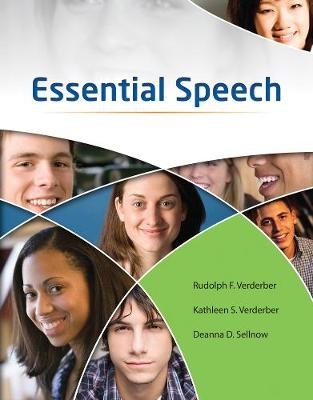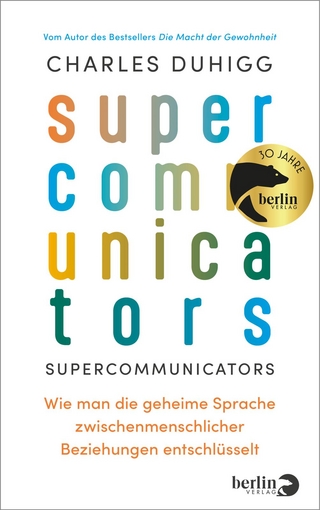
Essential Speech
South Western Educational Publishing (Verlag)
978-0-538-44990-8 (ISBN)
- Titel ist leider vergriffen;
keine Neuauflage - Artikel merken
Learn the basics of communication to mastering speech preparation and delivery with this engaging, dynamic text. ESSENTIAL SPEECH introduces the various types of speeches as well as the keys for effective speech preparation and confident delivery. Relevant activities and examples of effective and ineffective communication make learning easier.
Strong speeches begin with thorough preparation. Users develop into confident, competent communicators as they learn to research and use language and vocabulary effectively. Useful delivery strategies as well as how to perfect listening, observing, analyzing, and critiquing abilities are also addressed.
This book's inviting and open visual presentation, along with numerous examples drawn from today's world, keep the presentation meaningful and engaging. Numerous hands-on activities also keep users actively involved in learning. Ongoing review and assessment ensure understanding of the concepts before moving ahead.
Technology has had a huge influence on how you learn, how you work, and how you communicate today. The online Speech Builder Express tool solves the major challenges in this course: getting organized and comfortable to make a presentation, and relieving anxiety and stress caused by lack of planning and organization. Speech Builder Express coaches users through every step of the speech outlining process. By providing the necessary tutorials, sample videos, and access to a dictionary and thesaurus, this product will help build confidence, lessen anxiety, and prepare users for real-world career speaking opportunities. Discover all of the aspects of teaching speech – from concepts and practice to technology support. This book’s approach is based on extensive field research and input from Speech Educators across the nation.
Rudolph F. Verderber is Distinguished Teaching Professor of Communication Emeritus at the University of Cincinnati and former National Speaker's Association Professor of the Year -- as well as one of the all-time bestselling communication studies authors. The strength of his basic texts lies in his ability to explain and exemplify concepts, theories and skills to introductory level students. His Cengage texts -- COMMUNICATE!, THE CHALLENGE OF EFFECTIVE SPEAKING, COMM and SPEAK -- have a reputation for being student favorites due to their accessible presentation of theory and skills. Deanna D. Sellnow, Ph.D., is a Luminary Research Professor of Strategic Communication in the Nicholson School of Communication at the University of Central Florida. Her research focuses on the rhetoric of popular culture, particularly music as communication, and instructional communication as it occurs in conventional and nonconventional classrooms, as well as in risk and crisis contexts. Dr. Sellnow has published in regional, national and international journals and served as editor of the JOURNAL OF COMMUNICATION PEDAGOGY, COMMUNICATION TEACHER and the BASIC COMMUNICATION COURSE ANNUAL. She is co-author of COMMUNICATE!, THE CHALLENGE OF EFFECTIVE SPEAKING, COMM and SPEAK, all with Cengage. Kathleen S. Verderber is associate professor of management emeritus at Northern Kentucky University. She has consulted with various civic, professional and business organizations. Dr. Verderber has published numerous articles in several journals and presented papers at communication and management conferences. In addition, she is a co-author of COMMUNICATE! THE CHALLENGE OF EFFECTIVE SPEAKING IN A DIGITAL AGE, COMM and SPEAK, all with Cengage, as well as author of INTER-ACT: INTERPERSONAL COMMUNICATION, CONCEPTS, SKILLS, AND CONTEXTS with Oxford University Press. She holds an M.A. in speech communication as well as an MBA and a Ph.D. in organizational behavior from the University of Cincinnati.
1. WELCOME TO PUBLIC SPEAKING.
Understand Public Speaking. Communication Settings, Your Audience Matters. Give Effective and Enthusiastic Speeches. Effective Speech, Enthusiastic Delivery. Be Empowered and Ethical. Empowerment, Ethical Behavior.
2. SPEECH ANXIETY AND PLANNING.
Speech Anxiety. Understand Speech Anxiety, Manage Speech Anxiety. Effective Speech Planning. Be a Confident Speaker, Speech-Planning Steps. Narrative Speeches. Narrative Speeches, Develop a Narrative Speech.
3. LISTEN AND ANALYZE SPEECHES.
Listen Effectively. What Is Listening? Ways to Listen Effectively, Understand and Remember Information. Analyze and Evaluate Speeches. Critically Analyze Speeches, Evaluate Speeches, Receive a Critique.
4. SPEECH GOALS.
Speaking Situations Subjects and Topics. Identify Speaking Situations, Identify Subjects and Topics. Analyze the Setting and Audience. Analyze the Setting, Analyze the Audience, Audience Information. Collect Data About the Audience. Collect Data Through Surveys, Collect Data Using Other Methods. Select a Topic and Write Speech Goals. Select a Speech Topic, Speech Goals, Write Speech Goals.
5. CONSIDER THE AUDIENCE.
Relate to the Audience. Relevance, Initial Audience Disposition, Common Ground, Develop Audience Trust. Adapt for Your Audience. Adapting Strategies, Adapt for Diversity, Create a Specific Plan.
6. RESEARCH.
Locate Information. Research, Personal Knowledge Experience and Observation, Primary Sources. Secondary Sources. Secondary Sources, Types of Secondary Sources. Evaluate Information. Criteria for Judging Sources, Identify and Select Relevant Information, Include Cultural Diverse Views. Record Information. Preparing Research Cards, Citing Sources in Your Speech.
7. THE SPEECH BODY.
Main Points and Thesis Statement. Identify Your Main Point, Write the Thesis Statement. Outline the Speech Body. The Speech Body Outline, Outline Main Points, Subpoints. Supporting Materials and Transitions. Supporting Materials, Transitions in Speeches.
8. THE SPEECH INTRODUCTION AND CONCLUSION.
Create the Introduction. Goals of the Introduction, Outline the Introduction. Create the Conclusion. Parts of the Conclusion, Outline the Conclusion. Complete the Outline. List Sources, Write a Title, Review the Outline.
9. PRESENTATION AIDS.
Visual Aids. Types of Presentation Aids, Criteria for Choosing Presentation Aids. Create Visual Aids. Design Presentation Aids, Computer-Generated Presentation Aids and Multimedia Presentations. Display and Use Presentation Aids. Ways to Display Presentation Aids, Guidelines for Using Presentation Aids.
10. SPEECH WORDING.
Choose the Right Words. Oral Style, Speak Accurately, Speak Clearly. Speak Vividly and Appropriately. Speak Vividly, Speak Appropriately.
11. SPEECH DELIVERY.
Effective Speech Delivery. An Effective Delivery Style, Use Your Voice Effectively, Effective Nonverbal Language. Delivery, Rehearsal, and Audience Adaptation. Speech Delivery Methods, Rehearsal, Adapt to Your Audience.
12. INFORMATIVE SPEECHES.
Informative Speeches. Goal of Informative Speeches, Characteristics of Informative Speeches, Ways to Inform Your Audience. Types of Informative Speeches. Process Speeches, Expository Speeches.
13. PERSUASIVE SPEECHES.
Persuasive Speeches. Goal of a Persuasive Speech, Write a Persuasive Speech Goal. Identify Reasons and Evidence. Find Reasons to Use as Main Points, Find Supporting Evidence, Essentials of Reasoning. Motivate Your Audience. Types and Arguments, Credibility, Emotional Appeal, Ethics, Leadership. Organizational Patterns for Persuasive Speeches.
14. ANALYZING THE MEDIA.
Interpreting Media Reports. Media’s purpose, How media communicates. Interpreting Media Events. Media tools, Media Evaluation.
15. ORAL INTERPRETATION AND DEBATE.
Interpreting Creative Works. Oral Interpretation, Consider Your Purpose and Your Audience. Debate. Debate Essentials, Prepare for Debate, Lincoln-Douglas Debate.
16. GROUP PRESENTATIONS AND CEREMONIAL SPEAKING.
Preparing Group Presentations. Responsibilities of Group Members, Group Problem-Solving Methods, Preparation Process. Delivering Group Presentations. Group Presentation Formats, Evaluating Group Effectiveness. Speeches for Special Occasions. Welcome and Introduction, Recognition Nomination and Acceptance, Other Ceremonial Speeches.
Appendix.
Parliamentary Procedures.
| Verlagsort | Mason |
|---|---|
| Sprache | englisch |
| Maße | 224 x 284 mm |
| Gewicht | 1315 g |
| Themenwelt | Sachbuch/Ratgeber ► Beruf / Finanzen / Recht / Wirtschaft ► Briefe / Präsentation / Rhetorik |
| Wirtschaft | |
| ISBN-10 | 0-538-44990-X / 053844990X |
| ISBN-13 | 978-0-538-44990-8 / 9780538449908 |
| Zustand | Neuware |
| Haben Sie eine Frage zum Produkt? |
aus dem Bereich


